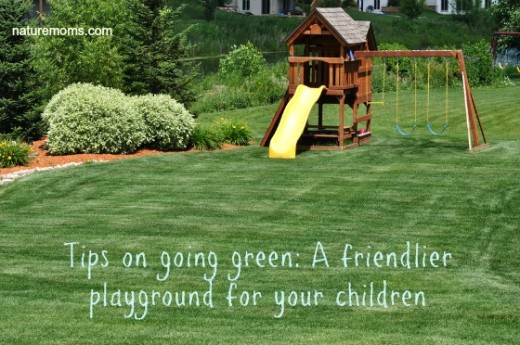Playgrounds are where learning and enjoyment meet together. As parents, you only want what’s best for your children. Luckily, you can also choose what’s best for the planet.
Here are some tips in choosing an eco-friendly playground for your kids to enjoy:
Safety first. More than anything, safety is of utmost priority. With much vigor the children have when playing, accidents are likely to happen. Therefore, look for playground surfaces that are good shock-absorbers. A great example of this is recycled rubber mulch which is processed from recycled tires and is non-toxic and inflammable. They’re known to provide twice the amount of protection (a 6-inch thick filling could protect a fall height of up to 12 ft.) and due to their strong odor and texture, do not invite insects and animals (unlike sand which animals use as litter box). Plus, because of its density, it holds your playground in safety. Durability can last up to 10 years. Beware, though, some recycled rubber when not properly cleaned may contain pieces of wire harmful for children. Also, mulch pieces that are too small may present a choking hazard. Rubber mulch may cost twice as much and requires constant maintenance. On the upside, you can save up on drainage maintenance because of its excellent drainage system.
Choose the most qualified materials. High-density polyethylene (HDPE) is the base of recycled plastic which can be used in manufacturing recycled playground equipment. Most environmental playground companies make recyclable plastic lumbers (RPL) using in-house lumber extrusion and make use of post-consumer recycled materials such as plastic milk and water bottles. Unlike other conventional materials, RPL does not rust, splinter, break down, nor does it need any staining-maintenance or waterproofing. Combining it with strengtheners and UV stabilizers results to incredibly high tensile and compressive strengths. Such product result is known to be extremely sturdy with the recycled plastic even lasting to 100 years! That’s guaranteed to be enjoyed by your children, your grandchildren, and your grandchildren’s children!
Health is wealth. Best avoid playgrounds which consist of plastic containing Polyvinyl Chloride (PVC) as
“…(A)dded stabilizers, plasticizers and fillers can leach and are potent hormone disrupters when ingested from little hands.”
Avoid lumbers which have been pressure-treated with Chromated Copper Arsenate (CCA), arsenic being a carcinogen linked to immune and cardiovascular diseases. RPL coloring is solid throughout unlike painted metal or steel in other playgrounds. Note that paint may harbour lead and ingested lead can cause damage in the brain and nervous system.
Look for something that’s easy to maintain. Should someone write or vandalize on your playground, here’s something to smile about: RPL resists graffiti. It’s protected from paint and ink too! Meanwhile for some recycled playgrounds faced with vandalizing dilemmas, it’s as easy as using sandpaper for buffing it out. Also, recycled playgrounds usually only require water and soap for cleaning. That’s hours and money saved on cleaning and maintenance!
Choose companies that are dedicated to quality and their cause. When looking for manufacturers, choose those that are dedicated to their craft with years of experience and consumer satisfaction to back it up. These are the guys you can rely on in terms of quality and integrity. Make sure you pick out those who are dedicated to their environmental cause, not using it for sole profit or advertising. You can bet these are the people who make sure they lessen their energy consumption and greenhouse gas emissions through HDPE recycling. Just to give you an idea, today’s HDPE recycling
“…saves 23.7 trillion British thermal units (BTUs) of energy – equivalent to the amount of energy consumed in one year by 125,000 American households. This savings equates to avoidance of 659,000 metric tons of carbon-dioxide – the emissions equivalent of 75 million gallons of gasoline.”
Fortunately, there are those who make sure they recycle the scraps they generate during production and use them to make packaging materials, for example, or have it sorted out for recycling elsewhere. I highly recommend those companies who use RPL in their playgrounds since RPL saves trees from being cut down for lumber and according to a report, a typical playground using RPL would’ve utilized about 31,500 to 63,000 water and milk containers. That’s A LOT of plastic saved from being dumped to landfills.
So before purchasing that kick-ass playground for your children, think about where it places (according to the above-listed tips). While putting your children’s safety ahead of everything else is perfectly reasonable, it wouldn’t hurt to think about the planet’s safety as well, once in a while.
Emily Harper is a busy housewife, and is also an active member of the neighborhood watch. She keeps her readers up to date with issues of sustainability and other home matters through writing. She lives with her husband, two sons and a cat named Theodore. To know more please check out her blog, SecurityOcean.Com.




Can you recommend any brands of safe recycled mulch or where to find it?